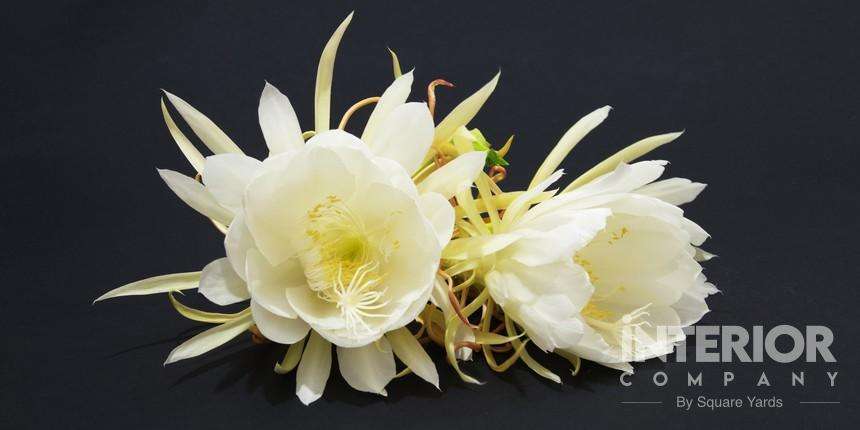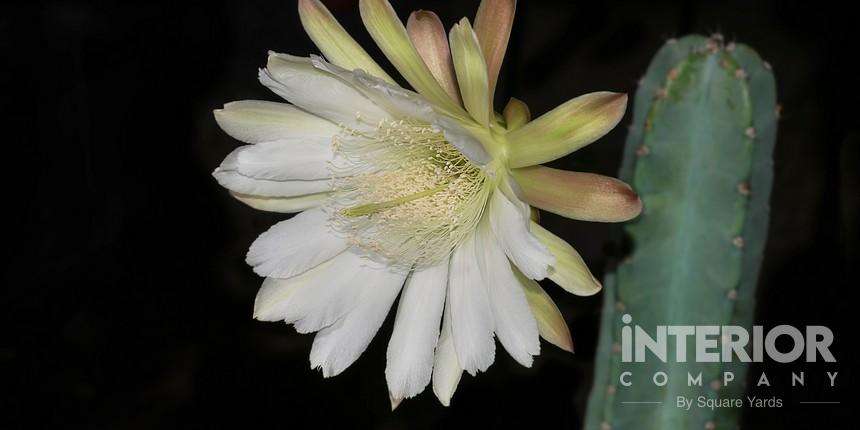- Kitchens
- Design Ideas
- Cities
- Trends
- Guides
- Price Calculators
- Our PortfolioNEW
- More
- Home
- Trends
- Furniture And Decor
- Indoor Plants
- Night Blooming Cereus Indp
Learn How to Grow and Take Care of Night Blooming Cereus
There’s no denying that adding greenery is the key to lend your abode a tinge of elegance and revitalization, be it indoors or outdoors; and the flower power is certainly unbeatable. While most of us have an impeccable variety of flowers in our home gardens, Night Blooming Cereus is a beautiful bliss to include in our collection as it calls for the attention from one and all. Also known as Epiphyllum oxypetalum, it is an unusual plant that opens its flowers only at night.
Table of Content
Learn about the basics of growing night blooming cereus
How to care for Night Blooming Cereus
Types of Night Blooming Cereus
- 3.1 Queen of the Night Cactus (Epiphyllum oxypetalum)
- 3.2 Red Orchid Cactus (Epiphyllum 'Fifty Grand')
- 3.3 Pink Orchid Cactus (Epiphyllum 'Thousand Pinks')
- 3.4 Hooker's Orchid Cactus (Epiphyllum hookeri)
- 3.5 Dragon Fruit Cactus (Hylocereus undatus)
- 3.6 Deer Horn Cactus (Peniocereus greggii)
- 3.7 Vanilla Cactus (Selenicereus grandiflorus)
San Pedro Cactus (Echinopsis pachanoi)
Cardeiro (Cereus jamacaru)
Night Blooming Cereus Cuttings
How to Propagate a Night Blooming Cereus
How to Care When a Cereus Cactus is Propagating
Well, you might not be aware that night-blooming cereus is the common name for several flowering ceroid cacti that bloom after dark. These little pretties are a quick way to bring color and excitement to a lifeless decor; and a rich, floral fragrance released out of the flower just perfumes the entire garden and induces a sense of absolute invigoration in the aura. Beyond that, these little babies also help in removing negative energy from the atmosphere, purifying the air, promoting a positive vibe, and boosting your mood in a jiffy.
Planning to spruce up your abode with the feel of flowers? Grow night blooming cereus in your garden which is also called the Queen of the Night or Princess of the Night. Apart from enhancing the feel of gardens, it can also act as an icing on the cake in the decorations for night parties. It is a catch-all common name for a huge variety of spineless, flowering cactus species. You would be surprised to know that Dutchman's pipe (Epiphyllum oxypetalum) and dragon fruit (Hylocereus undatus) are also referred to as night blooming cereus, and are also called 'orchid cacti' since they too bloom at night.
Learn about the basics of growing night blooming cereus
Night blooming cereus are grown as a houseplant in the warmest regions. During summer, these gorgeous plants demand a spot in the outdoors where there is morning sun or filtered light. Since the hot afternoon sun can burn their leaves, you need to move them inside or cover them during afternoons in order to protect them from the harsh sun rays. Spring and summer are the ideal seasons for the plant to produce new growth ; you need to water them regularly but make sure to allow the soil to dry out between waterings. The plants should be tucked into well-draining soil such as soilless container mix or cactus mix. The fertilization of the night blooming cereus is required with water soluble plant food every 10 to 14 days. They produce pencil-like leaves and flattened leaves; and the leaves that have been around two effective growing seasons develop flower beds forming in the scalloped indentations along their edges.
Night blooming cereus typically blossoms in the season of summer and fall. Things that help in the formation of flower bud include:
- Bright sunlight, but not extreme bright as mentioned above
- Frequent fertilizer once you move plants outside in summer
- Right winter treatment
- Keeping the plants a little rootbound
Once the flower buds start appearing in the plant, they develop gently. The flower stem tends to bend a few days before their opening, and the buds swell on their blooming day which is why petals are clearly visible and appear wavy and plump.
The plant opens its flowers usually between 8 and 9pm and the buds open gently releasing a rich, floral fragrance. They could be seen fully unfurled by midnight and close by the first light of dawn. The faded blooms drop naturally from the plant or can be gently broken. In case you wish to preserve an open flower to make the most of its beauty and fragrance, you can keep the stem in water in the refrigerator.
How to care for Night Blooming Cereus
As mentioned above, a night blooming Cereus grows in a place with bright sunshine and toasty temperature. Due to its extreme heat tolerance, it can handle temperatures over 100 Fahrenheit. If you are growing the plant in a pot, find the one with excellent drainage and fill it up with a cactus mix or gritty soil for better results. Spring is the time to fertilize the plant with a diluted houseplant food. If you find limbs getting unruly, trim them up without touching the cactus. You can save the cut ends of the plant to grow more Cereus night blooming cactus. Keep them out in your balcony or garden in summer, however, move them back in when temperatures start dropping.
Types of Night Blooming Cereus
There are ten most popular types of night blooming Cereus grown flamboyantly:
Queen of the Night Cactus (Epiphyllum oxypetalum)

Also known as “Dutchman’s pipe,” Queen of the Night Cactus species are white in colour and are native to rainforests, thus, require a little more watering than those to arid regions. Once you plant them, make sure their soil does not dry out completely. This plant needs to be fed every other week with fertilizer in the seasons of spring and summer. It can grow up to the height of 10 feet tall, but grows only 1 to 2 feet tall as a houseplant. They need to be planted in well-drained soil and demand bright sun exposure but not direct sunlight.
Red Orchid Cactus (Epiphyllum ‘Fifty Grand’)

Epiphyllum cacti or orchid cacti lie in plenty of cultivators. Renowned as Fifty Grand cultivator, this plant produces 8-inch, deep flowers in rosy-pink colour. This hybrid can be grown in a hanging basket; you can hang it in a pergola outdoors during summer season. This red hued plant grows 1 to 2 feet tall and it too needs to be planted in well-drained soil and demands bright sun exposure but not direct sunlight.
Pink Orchid Cactus (Epiphyllum ‘Thousand Pinks’)

Epiphyllum ‘Thousand Pinks’ is epiphytic in the wild and bears 6 to 8 inch flowers in pink colour. This genus grows perfectly on trees rather than in the ground, and requires a small amount of soil trapped in tree crotches. This is the reason these plants root bound perfectly well when they are treated with more soil in the pot. This plant reaches the height of 3 feet and the flowers turn into tasty edible fruit if pollinated. If planted in well-drained soil, they grow better. Moreover, these plants too demand bright sun exposure but not direct sunlight.
Hooker’s Orchid Cactus (Epiphyllum hookeri)

Epiphyllum hookeri has petals narrower than of Epiphyllum oxypetalum and are less fragrant. However, these plants require the same care as for Epiphyllum oxypetalum. Hooker’s Orchid Cactus grows from 1.5 to 3 feet tall with 9 inches long and 8 inches wide blooms. These pretties come in white colour and need to be planted in well-drained soil with bright sun exposure and no direct sunlight.
Dragon Fruit Cactus (Hylocereus undatus)

Dragon Fruit Cactus has large flowers and produces tasty, edible fruits in neon-pink colour. The flowers of these beauties appear in the month of July through October and demand more watering like Epiphyllum in hot weather than expected. You need to treat them with a deep watering thrice a week in the summer season. They require to be fed every month with a low nitrogen cactus fertilizer in this season, but do not require to be watered at all in winter. This plant reaches the height of 5 to 10 feet and features white flowers with yellow centre and outer petals. They require full sun exposure and well-drained soil to grow well.
Deer Horn Cactus (Peniocereus greggii)

Peniocereus greggii or Deer Horn Cactus is a varietal that can reach the height of up to 10 feet in the wild. It grows better in the wild when planted in sandy soil blended with caliche. If you plant it in a pot, it requires watering at least 3 to 5 times a month in a warm spot but a little less in a cool one. These plants barely demand watering in winter. For better results, feed them with a fertilizer two to three times in a year. Deer Horn Cactus grows in white and pink colour. Plant them in well-drained soil and at a spot where they can get filtered sunlight.
Vanilla Cactus (Selenicereus grandiflorus)

Selenicereus grandiflorus or Vanilla Cactus is another pretty night bloomer that is related to dog tail cactus. This varietal can bear a little more shade than other cacti and can reach the height of 1 to 2 feet. It needs to be planted in well-drained soil and should be placed in a spot with full sun exposure or partial shade. They grow in different varieties of colours such as pink, yellow, white and off-white, and require regular watering; but make sure to not overwater them.
San Pedro Cactus (Echinopsis pachanoi)

San Pedro Cactus is a columnar plant that can become 10 to 20 feet tall. It is a bit hardier than many night blooming cereus plants, and thus, can grow perfectly well outdoors. Multi-stemmed and fast-growing plant, Echinopsis pachanoi requires more sunlight and less watering than Epiphyllum. It is hallucinogenic and appeals to the eyes of gardeners with its refreshing white colour. Place them in a pot or container with fertile and well-drained soil and full sun exposure.
Cardeiro (Cereus jamacaru)

Cardeiro or Cereus jamacaru is a plant that belongs to the actual genus, Cereus, and is native to Brazil – a dry region in South America. Featuring white colour with pink outer petals, this tree-like plant reaches the height of 20 feet in the wild and grows tasty, edible fruit in pinkish-red colour. While watering, make sure to let the soil dry out first completely and is ready to be watered again. Plant Cardeiro in well-drained soil and place it in a spot with full sun exposure.
Peruvian Apple Cactus (Cereus peruvianus)

Varied in white and pink, Peruvian Apple Cactus or Cereus peruvianus is another type of night blooming cereus that grows edible fruit. You need to feed the plant with a slow-release fertilizer throughout the growing season in order to let it grow well. This plant requires deep watering thrice a week for the new growth and fruit production, however, it barely demands watering in winter. This plant can become 30 feet tall in the wild. Place it in a spot with full sun exposure and plant it in well-drained soil.
Night Blooming Cereus Cuttings
Night blooming cereus is one of the easiest cacti you can take the cuttings from. The good thing about this plant is it can root in a few weeks from the cuttings taken from its leaves in spring. It is easier to propagate night blooming cereus from cuttings than growing new plants from the seed. This leggy plant has flat leaves and gangly stems, however, it grows pretty well from wallflower. Since these cactus root fast and grow as single plants in less than a month, you can easily root night blooming cereus to create more plants. It is best to take cuttings from the plant during its growing seasons, spring and summer. This is the time when its cells are the most active and can effortlessly produce roots. It is recommended to take cuttings from the plant from clean and sharp implements. You need to take 6 to 9 inches long cuttings from terminal growth of the plant. You need to let the cuttings callus in a warm and dry spot for almost 2 weeks. It is a crucial step of rooting night blooming cereus since the root cells form from this callus. This dinner plate sized bloom is worth waiting for as they are certain to fill your beautiful abode with its rejuvenating fragrance.
How to Propagate a Night Blooming Cereus
First, you need to prepare a medium to propagate the cacti from callused plant material. It is required to plant it in a standard cactus potting soil or a blend of coarse sand and peat. Find a terra cotta pot or any container that drains well and is a few inches bigger than the diameter of the leaf. Insert the cutting into your potting medium and bury it in the pot about half way and make sure to firm the soil all around so as to remove any air pockets. Water it up now and keep irrigating frequently the way you water adult cactus. You need to keep an eye and not let the soil get soggy since it leads to the rotting of cutting that makes new roots melt away. Place the container in a cool and bright corner during the formation of the roots which takes about two weeks.
How to Care When a Cereus Cactus is Propagating
Now that you can see your cactus having roots, it is the time to move it to a location which is slightly warmer. You need to be aware that the cutting should not be replotted for a few years and it can grow on in its small container. Fertilize the cactus with a soluble plant fertilizer once every month during the growing season. In order to improve blooming, feed the plant with a high phosphorus just before the blooms come out. In case you witness any damage occurring to the leaves and stems, just cut it off and trim the portion with healthy tissue, allowing it to callus and propagating cereus anew. This will form many of these plants you would love to adorn your garden with or you might end up gifting so many to your loved ones as well.
Ready for a home transformation?
Let our designers assist you!
Recent Posts
Related Category
- Balcony
- Bedroom
- Home Decor
- Living Room
- Outdoors



































